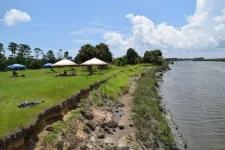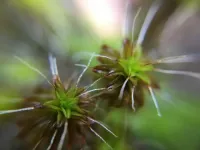(Press-News.org)
In a first-of-its-kind study published in the American Journal of Respiratory and Critical Care Medicine, physician-scientists from the University of Alabama at Birmingham Marnix E. Heersink School of Medicine discovered that high-dose inhaled nitric oxide therapy may improve oxygenation and reduce the risk of mortality among critically ill Black patients with COVID-19.
Acute respiratory distress syndrome, or ARDS, is a condition that most commonly occurs in the setting of a lung infection such as COVID-19.
“In ARDS, the barrier between the blood vessels and air sacs in the lungs is disrupted leading to the accumulation of fluid from the blood vessels in the air sacs, restricting air exchange in the lungs,” said Naman S. Shetty, M.D., a research fellow in the UAB Division of Cardiovascular Disease and the first author of this manuscript. “Poor air exchange in ARDS leads to organ damage and increases the risk of death. Therefore, increasing oxygenation in ARDS may improve survival and decrease organ damage. However, it may not be possible to maintain oxygenation in patients with ARDS when providing external support for breathing using a mechanical ventilator.”
During the peak of the COVID-19 pandemic, witnessing the ever-increasing mortality of COVID-19 patients led Pankaj Arora, M.D., the senior author of the manuscript and an associate professor in the UAB Division of Cardiovascular Disease, to collaborate with Lorenzo Berra, M.D., to initiate the NOSARSCOVID trial, an international multicenter trial to examine the effects of high-dose inhaled nitric oxide on improving oxygenation in COVID-19 patients who required support from a mechanical ventilator.
Trials are rare in critically ill patients due to enrollment difficulties; therefore, this effort provided a much-needed boost in critical care research during the pandemic. The primary trial revealed that high-dose inhaled nitric oxide therapy improved oxygenation.
As an extension of the NOSARSCOVID trial, Shetty and his team assessed whether racial differences in the response to inhaled nitric oxide were present. The trial recruited a diverse patient population, allowing them to effectively examine this research question.
“In the study, we evaluated whether the improvement in oxygenation and risk reduction in mortality differed among white and Black patients recruited in the trial,” Shetty said. “Inhaled nitric oxide therapy was associated with a larger improvement in oxygenation among Black patients compared with white patients. Most notably, inhaled nitric oxide therapy reduced the risk of death at 28 and 90 days in Black patients. This benefit was not observed among white patients.”
Arora says these findings may be due to differences in biological systems among different races and ethnicities.
“To ascertain that self-reported race could indicate biological differences, we used data from the All of Us Research Program and restricted the data to include populations where patients were recruited from in our trial,” Arora said. “This was done to determine whether the self-reported race is a good surrogate for genetic ancestry in these individuals. We found that the self-reported race in these geographical areas was a good proxy for genetic ancestry.”
Arora says the differences observed in this study may be attributed to differences in the nitric oxide system.
“Black individuals have been shown to have a suppressed nitric oxide system at baseline compared with white individuals,” Arora said. “The suppressed nitric oxide system in Black individuals increases their susceptibility to developing severe ARDS with a high risk of death. Treatment with inhaled nitric oxide overcomes this intrinsic deficit in the nitric oxide system in Black individuals.”
Arora says this study calls for a larger phase three trial to test the hypothesis in Black patients. Arora explains that, due to the complexity of conducting trials in critical care, the inclusion of a diverse population was traditionally placed lower on the list of priorities.
“Our study highlights that the treatment effect of an intervention may vary by race,” Arora said. “Therefore, there is a need for adequate representation of minority populations in large clinical trials. Furthermore, our study draws attention to the individualization of treatment based on the patient. Precision phenotyping techniques incorporating clinical, physiological, imaging and molecular markers may help guide physicians to individualize therapy in ARDS.”
END
New Orleans, LA. – Ochsner Digital Medicine has partnered with Humana Healthy Horizons to provide digital medicine services to its members. This agreement was effective February 1, 2024, with member enrollment in digital programs available immediately after.
Humana Healthy Horizons is Humana’s Medicaid plan for Louisiana, covering thousands of members throughout the state. Through this partnership, Ochsner Digital Medicine will offer Humana Healthy Horizons members who have been diagnosed with Hypertension and Type 2 diabetes remote programs designed to manage and control their conditions.
The programs use remote patient management through digital devices and personalized ...
Seattle is routinely listed as one of the most walkable and bike-friendly cities in the nation. The city government has committed to Vision Zero, which aims to completely eliminate traffic deaths and serious injuries by 2030, and embarked on a slew of infrastructure projects: expanding the city’s bike network, redesigning high-crash intersections and enhancing crosswalks to protect pedestrians.
Such safety projects sometimes meet opposition from local business owners, who worry that reduced parking and disruption ...
African apes are already being exposed to climate change impacts, and will experience extreme events such as wildfires, heatwaves and flooding more frequently in the next 30 years, according to a study publishing February 28 in the open-access journal PLOS Climate by Razak Kiribou at Haramaya University in Ethiopia and colleagues.
To better understand how African great apes will be affected by climate change, researchers investigated past and future climate for 363 sites across Africa. They estimated temperature and rainfall at each site between 1981 and 2010. Using two climate change scenarios, they projected how frequently apes would be exposed to climate change impacts in the near ...
Countries in the European Union (EU) have made progress over the past decade toward Sustainable Development Goal 7 (SDG 7), which calls for “access to affordable, reliable, sustainable and modern energy for all” by 2030, according to a study published February 28, 2024 in the open-access journal PLOS ONE by Marek Walesiak from Wroclaw University of Economics and Business, Poland, and Grażyna Dehnel from Poznań University of Economics and Business, Poland.
In 2015, the United Nations developed 17 global Sustainable Development Goals to be achieved by 2030. Tenets of SDG 7 include universal access to affordable energy; increased renewable energy ...
Thousands of historic and archaeological sites in Georgia are at risk from tropical storm surges, and that number will increase with climate change, according to a study published February 28, 2024 in the open-access journal PLOS ONE by Matthew D. Howland and Victor D. Thompson of Wichita State University and the University of Georgia.
Anthropogenic climate change poses a major risk to coastlines due to rising sea level and increasingly severe tropical storms. This threatens not only living populations but also historic and archaeological sites. Mitigating damage requires accurate assessments of risks, but most predictive models focus on projected ...
Pet dogs with diarrhea may be shedding multi-drug resistant E.coli in 5 in 10 cases, with potential risks to their human owners
###
Article URL: https://journals.plos.org/plosone/article?id=10.1371/journal.pone.0298053
Article Title: Characteristics of MDR E. coli strains isolated from Pet Dogs with clinic diarrhea: A pool of antibiotic resistance genes and virulence-associated genes
Author Countries: China
Funding: This research was funded by the National Key Research and Development Program of China (2018YFD0500900, ...
Harassment on public transport negatively impacts women's health and welfare, with existing measures being largely ineffective, per systematic review
###
Article URL: https://journals.plos.org/plosone/article?id=10.1371/journal.pone.0296830
Article Title: Invasion of privacy or structural violence? Harassment against women in public transport environments: A systematic review
Author Countries: Spain
Funding: This study has been supported by the research grant ACIF/2020/035 from the "Generalitat Valenciana". The funding entity did not contribute to the study design or data collection, analysis, interpretation, or writing the manuscript. There was no additional ...
RIVERSIDE, Calif. -- For centuries, coronaviruses have triggered health crises and economic challenges, with SARS-CoV-2, the coronavirus that spreads COVID-19, being a recent example. One small protein in SARS-CoV-2, the Membrane protein, or M protein, is the most abundant and plays a crucial role in how the virus acquires its spherical structure. Nonetheless, this protein’s properties are not well understood.
A research team led by a physicist at the University of California, Riverside, has devised a new method to make large quantities of M protein, and has characterized the protein’s ...
LA JOLLA, CA—Most cancers are thought to evade the immune system. These cancers don't carry very many mutations, and they aren’t infiltrated by cancer-fighting immune cells. Scientists call these cancers immunologically "cold."
Now new research suggests such cancers aren't as "cold" as once thought. Researchers from the La Jolla Institute for Immunology (LJI), UC San Diego Moores Cancer Center, and UC San Diego, have found that patients with "cold" tumors actually do make cancer-fighting T cells.
This discovery opens the door to developing vaccines or therapies to increase T cell ...
Imagine: You find the dried-up remains of a once green and lush philodendron on your bookshelf and realize you can’t remember the last time you watered your houseplants. You soak the soil with water, hoping you can breathe life back into its desiccated husk, but it is futile. The plant has been too dehydrated for too long, and irreparable damage has been done.
Now imagine that it isn’t your neglected houseplants that have been subjected to an unexpectedly dry growing season, but a field of wheat. With changes in global climate, such things are becoming more common and more of a concern for farmers, consumers, and researchers alike as the threat to food security intensifies.
But ...








